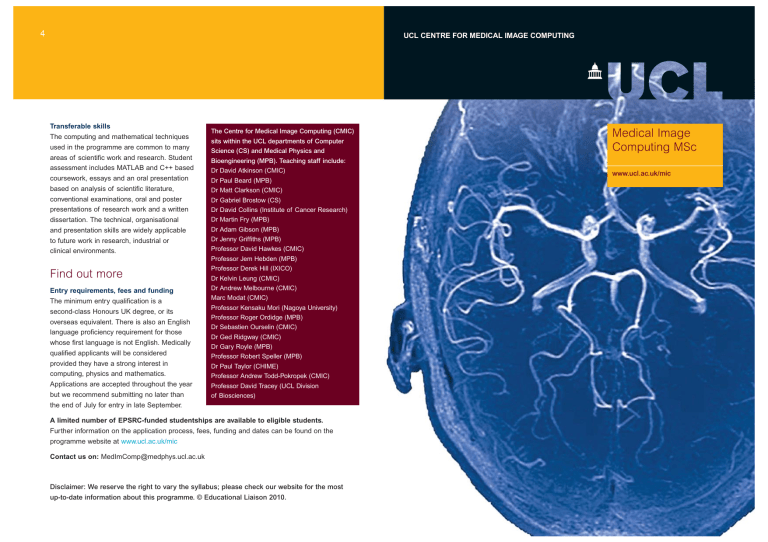Medical Image Computing MSc 4 UCL CENTRE FOR MEDICAL IMAGE COMPUTING

4
Transferable skills
The computing and mathematical techniques used in the programme are common to many areas of scientific work and research. Student assessment includes MATLAB and C++ based coursework, essays and an oral presentation based on analysis of scientific literature, conventional examinations, oral and poster presentations of research work and a written dissertation. The technical, organisational and presentation skills are widely applicable to future work in research, industrial or clinical environments.
Find out more
Entry requirements, fees and funding
The minimum entry qualification is a second-class Honours UK degree, or its overseas equivalent. There is also an English language proficiency requirement for those whose first language is not English. Medically qualified applicants will be considered provided they have a strong interest in computing, physics and mathematics.
Applications are accepted throughout the year but we recommend submitting no later than the end of July for entry in late September.
The Centre for Medical Image Computing (CMIC) sits within the UCL departments of Computer
Science (CS) and Medical Physics and
Bioengineering (MPB). Teaching staff include:
Dr David Atkinson (CMIC)
Dr Paul Beard (MPB)
Dr Matt Clarkson (CMIC)
Dr Gabriel Brostow (CS)
Dr David Collins (Institute of Cancer Research)
Dr Martin Fry (MPB)
Dr Adam Gibson (MPB)
Dr Jenny Griffiths (MPB)
Professor David Hawkes (CMIC)
Professor Jem Hebden (MPB)
Professor Derek Hill (IXICO)
Dr Kelvin Leung (CMIC)
Dr Andrew Melbourne (CMIC)
Marc Modat (CMIC)
Professor Kensaku Mori (Nagoya University)
Professor Roger Ordidge (MPB)
Dr Sebastien Ourselin (CMIC)
Dr Ged Ridgway (CMIC)
Dr Gary Royle (MPB)
Professor Robert Speller (MPB)
Dr Paul Taylor (CHIME)
Professor Andrew Todd-Pokropek (CMIC)
Professor David Tracey (UCL Division of Biosciences)
A limited number of EPSRC-funded studentships are available to eligible students.
Further information on the application process, fees, funding and dates can be found on the programme website at www.ucl.ac.uk/mic
Contact us on: MedImComp@medphys.ucl.ac.uk
Disclaimer: We reserve the right to vary the syllabus; please check our website for the most up-to-date information about this programme. © Educational Liaison 2010.
UCL CENTRE FOR MEDICAL IMAGE COMPUTING
Medical Image
Computing MSc
www.ucl.ac.uk/mic
2
MEDICAL IMAGE
COMPUTING MSc
Medical image computing applies computing technology to medical images for improved patient diagnosis, treatment and the understanding of disease. This MSc provides a rigorous background in medical imaging coupled with state-of-the-art medical image analysis.
Extracting quantitative data and monitoring changes from medical images is key to improving diagnosis, to providing treatment and surgery planning and in the follow-up of therapy. Increasingly imaging is seen as vital to drug development where the aim is to make drugs available faster and at a cheaper price.
This MSc programme is provided by the UCL
Centre for Medical Image Computing – a large interdisciplinary grouping of eminent researchers. Lecturers are drawn from both the centre and other areas of UCL such as the
Division of Biosciences. The centre and its clinical colleagues provide research projects that make up one third of the programme. UCL is ranked among the top five global universities
( Times Higher Education – QS World University Rankings 2009).
Previous MSc participants have come from a range of backgrounds including computer science, internet engineering, biomedical engineering, signal processing, natural sciences, physics, imaging and photography, hospital-based medical physics and medicine.
The programme equips students with the skills necessary to participate effectively in a research, industrial or healthcare environment. Students have gone on to work for medical imaging companies, to train in radiology and to enrol for PhDs and other graduate training.
OPEN DAY: See our website for open day dates: www.ucl.ac.uk/mic
Programme structure
Taken full-time, the programme lasts one year. Students take eight taught modules in the first two terms (listed below) and a research project during the third term and summer. The syllabus is summarised below with more details available from the programme website at www.ucl.ac.uk/mic
1: Foundations of
Anatomy and
Scientific Computing
• Anatomy and physiology lectures
• Dissecting room practicals
• MATLAB, linear algebra
• Fourier, signal processing
• Eigenvalues, SVD
• Radiological coordinate systems
• Geometrical transformations, DICOM
• Optimisation
2: Programming
Foundations: Medical
Image Analysis
• Introduction to programming
• MATLAB
• C/C++
• MATLAB graphical user interfaces
• MATLAB for publication quality figure
• Software Engineering
• Floating Point
Arithmetic
• Parallel Programming and graphics cards
3: Physics for
Imaging and Therapy
4: Image Processing
• Interactions
• Detectors
• Sources
• Dosimetry
• Introduction to MRI
• Introduction to nuclear medicine
• Radiation protection
• Statistics
• Digital images
• Segmentation
• Image transformations, grey-level and geometrical
• Morphological operations
• Image filtering
• Edge and corner detection
• Colour
• Template matching
5 and 6: Medical
Imaging (Ionising) and Medical Imaging
(Non-Ionising)
• Diagnostic radiology
• Computer tomography
(CT)
• Nuclear medicine
• Positron emission tomography (PET)
• Image reconstruction
• MRI
• Ultrasound,
• Optical imaging
7: Information
Processing in
Medical Imaging
• Medical image computing: diagnosis, therapy, understanding, statistics, clinical trials
• Image registration
• Image segmentation and classification
• Statistical parametric mapping (SPM)
• Insight toolkit (ITK)
• High performance computing, cluster computing, graphics cards (GPUs)
8: Image Analysis and Image Directed
Therapy
• Quantitative Imaging
• Imaging biomarkers
• Dynamic measures from DCE-MRI
• Image guided interventions
• Computer Assisted
Detection
• MRI diffusion tensor imaging and tractography
Research Project
(counts for 30% of total marks)
Examples of research projects have included:
• Water/fat imaging in MRI
• MRI artefact correction
• Analysis of
Alzheimer’s images
• Mammographic image analysis
• Vessel-based image registration
• Integration of fluoroscopy and interventional MRI
3

